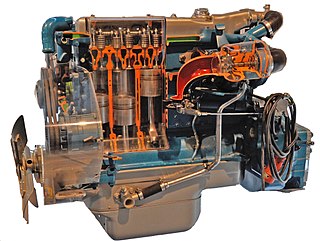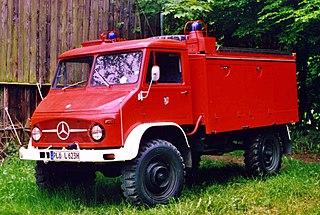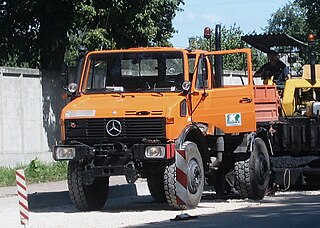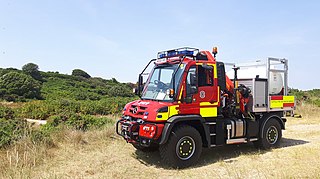
The Mercedes-Benz Group AG is a German multinational automotive corporation headquartered in Stuttgart, Baden-Württemberg, Germany. It is one of the world's leading car manufacturers. Daimler-Benz was formed with the merger of Benz & Cie. and Daimler Motoren Gesellschaft in 1926. The company was renamed DaimlerChrysler upon acquiring the American automobile manufacturer Chrysler Corporation in 1998, and was again renamed Daimler AG upon divestment of Chrysler in 2007. In 2021, Daimler AG was the second-largest German automaker and the sixth-largest worldwide by production. In February 2022, Daimler was renamed Mercedes-Benz Group as part of a transaction that spun-off its commercial vehicle segment as an independent company, Daimler Truck.

The Unimog is a range of multi-purpose tractors, trucks and lorries that has been produced by Boehringer from 1948 until 1951, and by Daimler Truck since 1951.

Bertha Benz was a German automotive pioneer and inventor. She was the business partner and wife of automobile inventor Carl Benz. On 5 August 1888, she was the first person to drive an internal-combustion-engined automobile over a long distance, field testing the Benz Patent-Motorwagen, inventing brake lining and solving several practical issues during the journey of 105 km. In doing so, she brought the Patent-Motorwagen worldwide attention and got the company its first sales.

The WF Trac is the current version of a tractor developed by Mercedes-Benz and based on their Unimog platform. It was originally known as the MB Trac. The WF Trac was developed by Mercedes-Benz between 1973 and 1991. During that time, its design featured four identical wheels, high road speeds, and powerful engines— a concept that was considered revolutionary.

The Mercedes-Benz OM 352 is a 5.7 litre inline-6 cylinder 4-stroke Diesel engine, made by Daimler-Benz.

The Mercedes-Benz Zetros is an off-road truck for extreme operations. It was first presented at the 2008 Eurosatory defence industry trade show in Paris. The Zetros is manufactured at the Mercedes-Benz plant in Wörth, Germany. The truck is designed to be compatible with the Hercules C-130 transport and also fits into a standard German railway carriage. In 2019 Mercedes-Benz presented a facelift of the Zetros with a more powerful engine a bigger number of variants.

The Pinzgauer is a family of high-mobility all-terrain 4WD (4×4) and 6WD (6×6) military utility vehicles. The vehicle was originally developed in the late 1960s and manufactured by Steyr-Daimler-Puch of Graz, Austria, and was named after the Pinzgauer, an Austrian breed of cattle. They were most recently manufactured at Guildford in Surrey, England by BAE Systems Land & Armaments. It was popular amongst military buyers, and continued in production there throughout the rest of the century.

The "New Generation“ is a series of trucks by Daimler-Benz built from 1973 to 1988. It was then replaced by the Mercedes-Benz SK series. With the "New Generation", Daimler-Benz expanded its market position in the medium and heavy truck segments. Its cab was also used by Mercedes-Benz of North America, who confusingly offered it with inline-six or -five engines as the LP series beginning in 1985.

The Mercedes-Benz OM 636 is a diesel engine that was produced by Daimler-Benz from 1948 until 1990. Being the successor to the OM–138, the OM–636 has been used both as a passenger car engine and as an industrial engine. It saw its first use in the Boehringer Unimog in 1948, prior to its official introduction in the 1949 Mercedes-Benz W–136. Throughout the 1950s, the OM–636 was widely used in the Mercedes-Benz W 120. In 1958, it was succeeded by the OM 621 passenger car engine. However, after the introduction of the OM 621, the OM 636 was kept in production for industrial vehicles such as small lorries, boats, and combine harvesters, until 1990.

The Borgward B 611 is a light commercial vehicle built by Borgward at their Bremen factory between 1957 and 1961. The nominal load capacity at launch was 1.5 (metric) tons. The vehicle was offered as a light van, a minibus or as a platform truck (Pritschenwagen), though various other body variants were available either directly from the manufacturer or from appropriately specialist vehicle body manufacturers.

The Unimog 435 is a vehicle of the Unimog-series by Mercedes-Benz. 30,726 vehicles were produced from 1975 to 1993 in eight different variants in the Mercedes-Benz Unimog-plant in Gaggenau. The vehicles were sold as Unimog U 1300 L and Unimog U 1700 L. Best selling vehicle was the U 1300 L, which was built as a special vehicle for the Bundeswehr and the German fire department often. The successor Unimog 437 with a similar appearance is still in production. The Unimog 436 is based on the Unimog 435. It is made for export and has a different cab. The names of Unimog-vehicles may create confusion, the U 1300 belongs to the Unimog 425-series, while the U 1300 L belongs to the Unimog 435-series.

ZT 300 is a series of 20 kN agricultural tractors, produced from 1 September 1967 to 1984 by the VEB Traktorenwerk Schönebeck. It succeeded the RS14 Famulus series, and unlike the Famulus, the ZT 300 series was sold under the brand name Fortschritt. ZT 300 refers both to the initial ZT 300 model, and the ZT 300 series. In total, 72,382 units of the ZT 300 series were made. The model with the highest production figure was the ZT 303, which was introduced in 1972. It features an automatic all-wheel-drive system; in the early 1980s, it cost 81.000 Mark. Starting in 1983, the ZT 300 series was succeeded by the ZT 320.

The Unimog 404, also called the Unimog S and Unimog 404 S, is a vehicle of the Unimog-series by Mercedes-Benz, produced in the Unimog plant in Gaggenau from 1955 to 1980. Marketed as Unimog U82, and later Unimog U110, 64,242 units of the two Unimog 404 types 404.0 and 404.1 were built, which makes the 404 the Unimog model with the highest production figure of all Unimogs. Unlike the Unimog 401, the 404 is rather a small 1.5-tonne-offroad-truck than an agricultural vehicle. In Germany, it was a common military vehicle and fire engine, 36,000 Unimog 404 were made for the Bundeswehr.

The Unimog 401 is an all-wheel-drive vehicle of the Unimog-series by Mercedes-Benz, developed as a tractor and equipment carrier. It was produced by Daimler-Benz in the Unimog plant in Gaggenau from 1953 to 1956. A total of 16,250 Unimog 401 and 402 were made.

The Unimog 406 is a vehicle of the Unimog-series by Mercedes-Benz. A total of 37,069 units were manufactured by the Daimler-Benz AG in the Unimog plant in Gaggenau from 1963 to 1989. The 406 was the first medium duty Unimog, having a larger wheelbase of 2380 mm and more than twice the engine power of the Unimog 401. Unlike the initial Unimog, the 406 does not have a car engine but a heavy duty truck engine instead. Several following Unimog versions were based on the 406. There were eleven different types made of the Unimog 406, which were available in four models with a closed two-door or four-door cab, as Cabrio and as an OEM part. During its long production period, the 406 received several technical refinements. In 1964, the precombustion chamber diesel engine OM 312 was replaced with the direct injected OM 352. Disc brakes followed in 1973. For many enthusiasts, the Unimog 406 represents the classical Unimog, having agricultural and silvicultural applications. It was successful and the best embodiment of the word Universal-Motor-Gerät considering all prior Unimogs.

The Unimog 2010 is a vehicle of the Unimog series made by German manufacturer Daimler-Benz from June 1951 to August 1953 in the Mercedes-Benz Gaggenau plant. It is a technical copy of its predecessor, the Unimog 70200. Despite being sold by Mercedes-Benz dealerships, the Unimog 2010 did not feature the brand's „Mercedes-star“ emblem. Instead, it was solely sold under the Unimog brand, having the ox-head-Unimog emblem on the bonnet; only vehicles purchased by the Swiss army lack the Unimog emblem and have no branding at all. In total, 5,846 units were produced, and five different models were available. All Unimog 2010 vehicles have a wheelbase of 1,720 mm and a canvas roof; a closed cab was not available as a factory option. The name „Unimog 2010“ originates from the German supply firm Erhard & Söhne, which manufactured the Unimog prototypes – all technical drawings, parts and tools of that firm had the part number 2010, which is said to be the reason why Daimler-Benz simply named the Unimog 2010. The Unimog 2010 was succeeded by the Unimog 401 in 1953.

The Unimog 70200 is the first series production model of the Unimog series, made by Gebr. Boehringer. It was manufactured in Boehringer's Göppingen plant from June 1948 to April 1951. In total, 600 units of the 70200 have been made. Manufacture of the Unimog was sold to Daimler-Benz in October 1950, where it was modified for mass production. This mass production optimised Unimog is known as Unimog 2010.

The Unimog 421 is a vehicle of the Mercedes-Benz Unimog series, made by Daimler-Benz. In total, 18,995 units of the Unimog 421 were built from 1966 to 1989 in the Mercedes-Benz Gaggenau plant. It is a medium-sized vehicle bigger than the traditional Unimog 411, but smaller than the Unimog 406. Introduction of new heavy models and Unimog 411 production ceasing in the mid-1970s changed the Unimog 421's role in the Unimog lineup; it became the predecessor of the light Unimog series and thus succeeded the Unimog 411.

The Unimog 425 is the first series production heavy duty Unimog series, made by Daimler-Benz from 1975 to 1988 in the Mercedes-Benz Gaggenau plant, alongside the long-wheelbase model Unimog 435. It was first presented to the public on the 1974 DLG show in Frankfurt, then named Unimog U 120, indicating a power output of 120 PS. However, series production models were equipped with 125 PS or 150 PS engines, and therefore called U 1300 and U 1500. Daimler-Benz made three types of the Unimog 425, and a total number of 3135 were built, making the 425 much rarer compared to the longer wheelbase, but otherwise similar Unimog 435, of which more than 30,000 were built. The 425 was the first Unimog to feature the "edgy cab", which is still used in the Unimog today.

The Unimog 405 is a vehicle of the Unimog-series by Mercedes-Benz, made by Daimler Truck Holding AG. Developed in the 1990s, the Unimog 405 has been in production since 2000. Originally, DaimlerChrysler produced the Unimog at Gaggenau; in 2002, production was moved to Wörth am Rhein. The Unimog 405 is the implement carrier version of the Unimog and the successor to most previous Unimogs. Although retaining many characteristics typical of the Unimog, the 405's axle and chassis design concept with control arms instead of torque tubes marks a "paradigmatic change" in Unimog design.




















